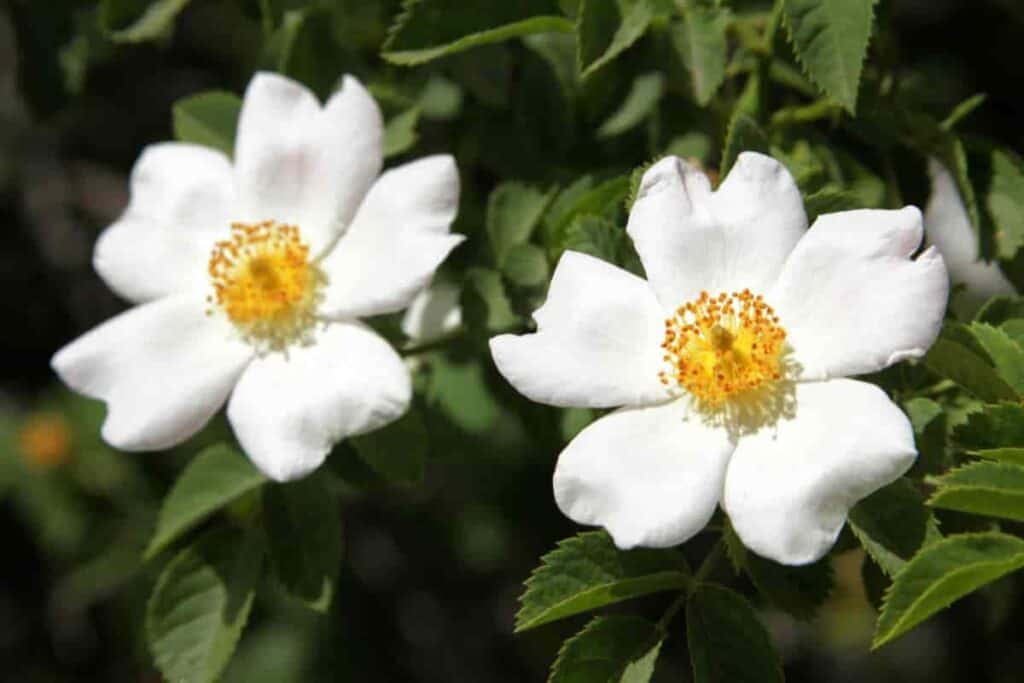Winter is a good time to think about roses, for we usually order some early in spring, and the earlier, the better, providing the ground is suitable.

So let’s think a little about some kinds of rose we can enjoy. There are many we like, have tried and found they only stayed with us for one or two years.
Scotch Roses
We return to those good old reliables that rose care little for winter and do not require coddling.
Most of us like the Scotch Roses, especially the Harridon’s – yellow, which seems to have a special sentimental value as one of the fragrant bright-blossomed fragrant shrubs in mother’s old-fashioned garden.
Another Scotch rose I like very much is a single white one called Altai spinosissima rosea.
Although these botanical names are very clumsy, it is still important to know them to make a proper distinction in our roses.
For instance, this has been known to me as Memorial Rose because it blooms on Memorial Day.
White Memorial Rose
Another also bears that name – a glossy leaved creeper or rose climber that beats its fragrant white flowers in clusters.
This is correctly known as Wichurana Rose, an ancestor of most hardy climbers.
My White Memorial Rose is a bush of dwarfish statute 5′ or 6′ feet. I have seen it planted in hedges but prefer it as a single specimen bush.
In fact, it will not remain so long, as like the Harrison Yellow, it sends out underground’ shoots or roots, making new plants.
These may be used to increase or cut off if desired. It depends on your room and how neat you keep your garden.
As its name indicates, this rose is very spiny, with erect or arching stems whose leaflets are from 5 to 11.
The large flat milk-white single flowers are borne in great profusion on the arching sprays and later on give over to blackish purple fruits.
Leaflets Of This Rose
The leaflets of this rose are quite tiny. Nevertheless, this is a good rose to have. Another rose I like very much is the Sweet-Briar or Eglantine.
In my childhood, one such rose grew in my father’s garden near the sidewalk, and I remember how passersby would snip off a leaf or two to enjoy its fragrance.
The leaves or leaflets scent green apples when wet; the flowers are pale pink a couple of inches across.
I searched for a long time before finding a specimen. The double French Rose, gallica as well as the Sir Thomas Lipton rugosa, does the best for me in a warm moist June.
Multiflora Rose Root
A red rugosa suffered a strange fate. One winter, rabbits ate it nearly to the ground. After that, it put up new shoots which bore clustered single flowers like large strawberry blossoms.
Then I knew the bush had been grafted on a multiflora rose root. It has made a nice shrub and does not spread as is sometimes advertised.
We must not pass by the Prairie Rose, the state flower of Iowa. It is not found much in gardens, and we have only to go to the roadside to enjoy its beauty.
When taking lunch to the field, I have often paused a moment to give it a loving look.
Prairie Rose
My people who came from England in the early days noticed and loved the wildflowers here, which grew in great abundance at one time.
The Prairie Rose was one of these. At that time, it grew in the wheat fields, highly out of place, and its red hips showed up in the fall stubble.
We must thank many hardy roses for their ancestry in some of our lovely present-day hybrids.
44659 by NA
